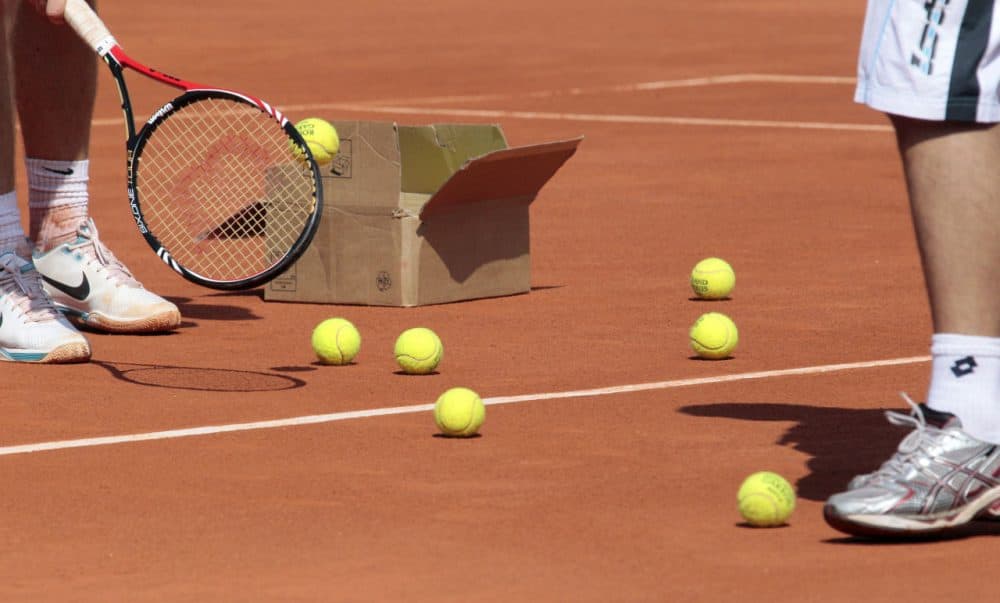Advertisement
A Magazine Editor's Attempt To Get (Very) Good At Tennis
Resume
"Finally, I wanted, one last time perhaps, to struggle at something I could control. Because the last real struggles were going to be ones I could not." — Gerald Marzorati
The struggles Gerald Marzorati, magazine editor, worried about, the ones he felt he wouldn’t be able to control, are the ones that frighten lots of people. Maybe almost everybody. The ones that end in death. Gerald Marzorati wanted to be serious about the struggle against that decline. He wanted to see how good he could get at something before he couldn’t get better at anything. So he took up tennis. Seriously.
"It wasn’t that I just wanted to learn how to knock the ball around well enough to make friends at a tennis club," Marzorati says. "I wanted to learn the proper way — even though it was going to be difficult, because I was in my mid-50s at that point."
It was also going to be difficult because Marzorati didn’t have much of a head start.
"I was never an athlete," he says. "I wanted to be when I was a kid and a teenager. I was always the shortest and skinniest kid in my school. It was a blue collar, mostly Italian-American school, where the kids started shaving at 9, and they were muscled up and bigger than me, and faster than me, and stronger than me."
In his mid-50s, Gerald Marzorati, editor of The New York Times Magazine between 2003 and 2010, was out from under the shadows of those hulks. He decided he wanted to become the best tennis player he could be. He worked at it much more diligently than most novice players would have done: practicing, traveling to clinics, competing against players who were better and much better than he was, all in the service of learning. And he found a philosophy to sustain him along the way. It comes from a line in Samuel Beckett’s "Worstword Ho," and it goes like this: “Ever tried. Ever failed. No matter. Try again. Fail again. Fail better.”
"It’s a quote that’s really about staying at it and trying again and again and trying to get better and trying harder to get better," Marzorati says.
But Gerald Marzorati, magazine editor, didn’t find those lines in a book.
"It is a line that's tattooed onto the arm of a Swiss player named Stan Wawrinka," Marzorati says. "Stan has, maybe, the most beautiful backhand, one-handed backhand, in tennis in general. It’s a shot that I have spent years trying to develop. It's considered the hardest shot. And I kept a copy of Tennis magazine propped open above the toilet in my bathroom. It’s on a spread where you see, sequentially, how he makes this shot. And I would just stare at this whenever I was in the bathroom."
Philosophy made it on to the court, too. Marzorati found a coach named Kirill, a tennis pro whom he calls “my Russian philosopher.”
"He knew how to keep me positive," Marzorati said. "If we were having a session and I was just dumping backhand after backhand into the net, he’d start hitting to my forehand."
Sometimes the attempt to get as good as he could be at tennis hurt. Especially in the elbow, the shoulder and the knees. Nor was it always comfortable in the head, because sometimes the quest led Marzorati, the dedicated tennis player, patron of private clubs, into a past where he found he no longer quite fit.
"I walk into an Italian deli in Florida, where I’m actually working with a tennis coach at one of these tennis academies, and that world of my childhood comes back to me, and I’m sitting in my tennis whites, and I do feel alienated in some weird way," he recalls. "I feel like what am I? I feel out of place here in the kind of place where I should feel most at home."
The trade-off was that by means of his association with tennis pros and tennis clubs and seniors who were former pros and had the leisure to play tennis all the time at those tennis clubs, Gerald Marzorati, magazine editor, became a better tennis player. Not a great tennis player, to be sure. Not even a good enough tennis player to much trouble those seniors who’d been playing tennis seriously since their teens. In tournaments, they beat him easily. But Marzorati got good enough to make worthwhile the quest he’d undertaken — and about which he’s written in a book titled "Late to the Ball."
I’m getting better, if I’m able to put in the time, have the will. It’s my story. At least for a little while longer.
Gerald Marzorati
"I think I did learn more about myself through this journey that I took to become a better tennis player," Marzorati says. "On a tennis court, I really saw how impatient I was. As a result I think I’m somewhat more patient. I also think I felt my age. I didn’t feel youthful. I was sore. I was whiney and aching. I think I felt more intensely what it is to be in my 60s."
Weird. Who wants to feel that? I’m there and it’s not that great. But it’s all worked for Gerald Marzorati. Fine. And more importantly, he’s made of the tennis experience what he’d hoped to make of it when it began, and he talked about struggle, and the meaning of struggle, and how little any of us finally have to say about how the struggle turns out.
"I was in control of the narrative," Marzorati says. "Unlike some of the narratives I am not in control of, it’s a narrative where I’m improving. I’m getting better, if I’m able to put in the time, have the will. It’s my story. At least for a little while longer."
Gerald Marzorati had ambitions beyond tennis when he undertook his quest, or perhaps he discovered them along the way. I, for one, am glad he shared them, in all their ambiguity and, perhaps, their desperation.
This segment aired on May 21, 2016.
